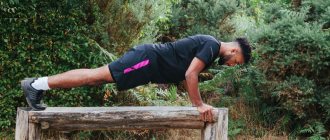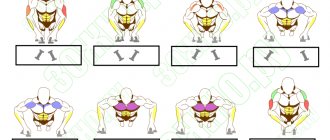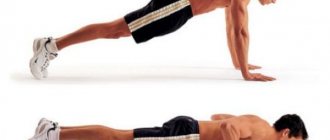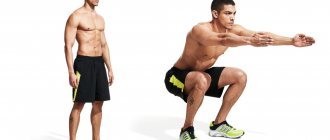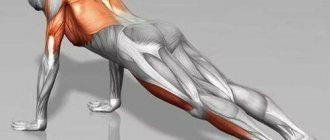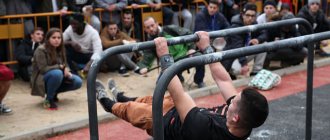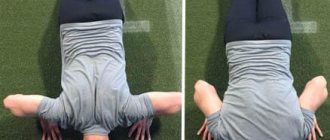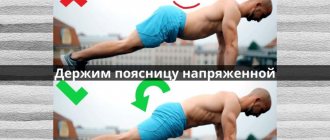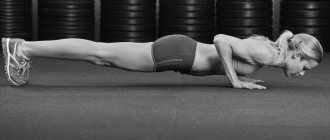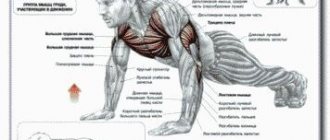This 17 push-up workout to failure will test your endurance and tone your pecs, triceps and shoulders.
Are your pecs or shoulders lagging, or maybe your triceps need a serious shake-up to get them growing?
Or perhaps you'd like to improve their shape and size while maximizing your metabolism while reducing your fat percentage to the single digits? Do you want to know what types of push-ups are for different muscle groups?
If you answered “yes” to any of these questions, then the program and methodology below may be just what you need.
The workout described is challenging and will require your utmost physical strength, but in the end, every drop of sweat will be worth it.
On fingers
Few people can do push-ups on their fingers. The difficulty is that people's finger joints are usually not strong enough to support the weight of their own body. Otherwise, the exercise is no different from the classic version.
First, you need to position your hands so that at least four fingers of each hand touch the floor. With experience, and when the joints become stronger, the number of fingers on which the athlete will lean can be reduced.
This option has the same emphasis on the muscles as in classic push-ups: pectoral muscles, triceps and anterior deltoids. But you should also take into account the extreme stress on your finger joints.
Push-ups training program: diagram and description
A program for beginners is usually built on this principle. Three push-ups are performed for each approach. The break between the first approaches is one and a half to two minutes; in just one set you need to do ten approaches. After the tenth approach, the athlete rests for three minutes, and then performs two more approaches with the maximum possible number of repetitions (push-ups). The pause between these approaches is also three minutes.
Initial level of push-ups table
At the first level, the athlete performs ten repetitions during one set. The pause between approaches is still no more than two minutes. In the final part of the workout, he does two sets of maximum repetitions, resting three minutes between sets.
First level of push-ups table
At the second stage, in the first part of the lesson, approaches with fifteen repetitions are performed, otherwise everything remains the same.
Second level push-ups table
Then the number of repetitions in the first part increases to twenty-five.
Third level of push-ups table
And after mastering this level, the second part becomes more complicated: instead of two approaches with the maximum number of repetitions, five such approaches are performed, with three minutes of rest between them. The number of repetitions in each approach of the first part is thirty times.
Fourth level of push-ups table
At the last level, the number of repetitions in each approach of the first part reaches thirty-five, and in the second part five final approaches are performed with the maximum number of repetitions performed.
Fifth level of push-ups table
In the future, it will be possible to increase both the number of repetitions of the exercise and the total number of approaches. It is not recommended to shorten the duration of rest between them, because this can lead to muscle overload.
By mastering different ways of performing this exercise, you can get very good results even without exercise equipment, due to the weight of your own body. This approach to exercise minimizes the likelihood of injury and damage to ligaments and muscles.
With your feet on the wall
This type of push-up is difficult because the athlete needs to keep his feet resting against the wall throughout the entire movement. To do this, he will have to strain his deltoids and arm muscles, “pressing” his feet into the wall so that they do not slide vertically.
The technique with feet on the wall is no different from classic push-ups, except that the feet are placed on a vertical wall.
This exercise actively works the spinal stabilizer muscles, as well as the deltoid muscles.
One-arm push-ups
This is a very difficult exercise that requires impressive physical fitness and developed balance.
In order to do push-ups on one hand, you need to place it at the level of the center of the chest, and spread your legs wider than your shoulders.
Handstand push-ups
Another very physically difficult option for performing push-ups, which not everyone can do.
In order to perform the exercise, you need to position yourself against a wall, then stand in a handstand, leaning your back against the wall. From this position the movement will take place. This option can be very dangerous, so you definitely need to put something soft under your head, and it’s best to do these push-ups with an assistant.
This exercise works the upper pectoral muscles and deltoid muscles.
Read more about upside down push-ups →
Types of push-ups
Which muscles are pumped during push-ups largely depends on the type of exercise chosen. There are variations of push-ups where the load is more on the chest, triceps or back.
Push-ups with wide arms
How to properly do push-ups with a wide grip? This variation is designed to shift body weight to the pectoral muscles. Push-ups for the pectoral muscles have several nuances that should be kept in mind while performing them:
- Try not to lift your pelvis too high.
- Your back should not sag, tense it.
- You need to lower yourself until your shoulders are parallel to the floor.
- Additionally, contract your chest muscles at the lowest point.
Close grip push-up
How to do push-ups correctly to load the triceps muscles? Place your hands as close to each other as possible. For balance, you can spread your feet slightly apart. Remember, the closer your palms are, the harder your triceps will have to work.
Fist push-ups
This push-up variation is suitable for people who experience wrist discomfort. In this case, the weight will shift to the knuckles. You can alleviate the pressure by placing something soft under them. The posture for push-ups on fists corresponds to the starting position for the standard version of the exercise.
Plyometric push-ups
The initial position is the same as for push-ups with mid-arm position. The only difference is that during the upward movement, you need to make an explosive force to push your torso up, lifting your palms off the ground. The feet remain in the same place. Clap in the air, land, and do the required number of repetitions. This way you can target your chest, shoulders and triceps even more effectively.
Legs on a stand
This version of push-ups is aimed at pumping the upper fascicles of the chest. The only difference from the standard position is that the legs must be placed on an elevation so that they are slightly higher than the head. The higher you are, the more weight will be placed on your chest.
Now you know how to do push-ups correctly in order to pump up a particular muscle group.
Train the technique and over time you will acquire a sculpted body and will be able to master the most difficult types of this exercise. Download WordPress Themes Freeonline free course
Spider-Man
This type is a push-up with an additional movement - moving the leg to the side. The athlete, bringing his leg parallel to the floor to the side towards the shoulder, bends it at the knee. The leg is suspended and should not touch the floor.
Starting position – lying down. The exercise begins with a downward movement, as in the classic version, but while lowering the body down, the athlete raises the knee of one leg to the elbow. Then a return to the starting position occurs and the exercise is repeated with the other leg bent.
The exercise involves all the muscles that are involved in the work when performing the classic version, but the spinal stabilizer muscles are also actively involved.
Correct breathing
Few beginners think about how to breathe correctly when doing push-ups. In practice, the effectiveness of this exercise largely depends on breathing.
Correct breathing during push-ups should be like this: when moving down, you need to inhale deeply, using the abdominal muscles. As you rise to the top position, slowly exhale. It is necessary to exhale at the moment of greatest muscle tension, when the muscles are trying to cope with the load.
Beginners often hold their breath while doing push-ups. This mistake leads to the fact that over time the muscles do not have enough oxygen, and you cannot perform the number of repetitions that you could easily do with normal breathing. Avoid this mistake if you do not want to over-stress your cardiovascular system.
With clap
These push-ups are very difficult, and even dangerous, because if you don’t have time to do the clap, you can hit your face on the floor. In principle, these are ordinary push-ups, which are complicated by an additional element - “clap”. This is where their complexity lies, because in order to perform a clap, you need to throw your torso as high as possible with a sharp springing movement, pushing off the floor with your hands, then make a clap and, having managed to put your hands up, land on the floor. If the first repetition of this exercise is not difficult to do, then with each subsequent repetition it becomes more and more difficult.
Take a leaning position with your arms outstretched. For a powerful “push” with your hands, you need to lower yourself to the lowest point of the amplitude and sharply push off from the floor as hard as possible.
The next element is cotton. It should be done at chest level and put your hands towards the floor as quickly as possible.
In this exercise, it is very important not to straighten your arms at the elbow joints after clapping. This is very important, since when you “fall” down, a shock is created that falls on the joints.
The exercise involves all the muscles that are involved in the work when performing the classic version. Due to the jerking technique, which an athlete cannot do without when performing push-ups with clap, explosive strength develops.
And also read: Plyometric push-ups: options → Push-ups from the floor with weights → Push-ups with dumbbells: technique and options →
What can you pump up with push-ups?
There are many types of this exercise. By varying them during one workout, you can build a beautiful, evenly toned body.
If you take regular push-ups, what muscles are pumped while doing them? Basically, any push-up is the same as a press, but performed with your own weight.
They engage the chest, triceps, lower back, and abs. Static load also falls on the wrists, muscles of the hand and legs.
For example, by doing push-ups with a narrow grip, you will evenly distribute your weight across all bundles of the pectoral muscles. By raising your feet higher than your body, you will shift the load to the upper bundles. If the shoulder girdle is significantly higher than the body, the weight will fall on the lower pectoral bundles.
Thus, by varying the technique, you can achieve maximum development of individual muscles. The push-up technique, if followed, will bear fruit very quickly. A few workouts a week for a month will show you how easy it is to change your body for the better.
